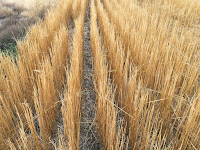What a disappointment to have this outfit on our property. The only thing good about this is that they came quickly and sucked up acres fast with three swathers and four balers. They wanted this long (stripper headed) straw. When the main field was baled, they estimated 3000#/a. We are getting $10/t, but that's about a third to a half of the value of the nutrients that we are losing through this removal process, plus the loss of carbon from the removed residue. We will have to put up with stacks of bales for 90 days while they age and ready for the mushroom industry. A constant reminder of failure.
This was an extra ordinary year in many aspects. Generally, this year, the spring crops were good to excellent for potential. The late spring start ended up with a late harvest for many operators. Even though most everyone has crop insurance, this is not going to be a good year for those that still have crop to harvest (now it is moving into the latter half of October). There are thousands of acres of garbs, spring wheat, and even some winter wheat still in the field. In my 65 years of being in the field I don't remember ever seeing harvest in this area this late. Our spring wheat crop averaged ~65b/a, with a range of 40-130b/a across the fields. Even the heavy high yielding areas, as pictured here, only produced ~ 4k#/a residue, which is nothing compared to the 20k#+/a that we had successfully drilled with the CrossSlot, the spring of 2014. We never expected to have any trouble drilling into this residue, but after several fitful days of adjustment, and even putting all new coulters on the drill, we admitted defeat and looked at alternatives, --either bale or fire. We chose bale, as the lessor of two evils. Fire, although the ground and surface residue was damp, may have caused more damage by burning into the soil where partially decayed residue resided. Cultivation was never considered due to it's lasting destructive effect on soil health. We are too far along the path to a healthy soil to revert back to that destructive practice.
WHY ARE WE HAVING THIS TROUBLE? We were convinced the CrossSlot was a foolproof drill capable of drilling any field condition where crops are grown without any field preparation? One caveat we knew was that the residue needed to be dry so the notched coulter could cut at least most of the residue it encountered. This residue appeared dry, but it was tough. My serrated clipper struggled cutting the residue at ground level, and you could ring a shock of stubble in your hands and not break it apart. Our rational then became, --we had never drilled into spring or winter wheat stubble that had not first gone through a winter, hence, some decomposition had taken place prior to any attempt to seed into the residue.
THEN CAME ANOTHER SURPRISE! The pic above is part of a 3ac, three cornered patch that was not baled. This was one of our higher yielding areas. The day after the remainder of the field was swathed and baled, Kye was able to drill this patch without any issues,--WHY??? The simple answer is: --The residue became cut-able! Time had given us enough dry days to lower humidity to the point the residue could be broke apart.
Well, we lost this years residue on these fields but it is worth the knowledge gained, being,--one, we don't necessarily have to wait for wheat stubble to deteriorate by going through a winter, and, two, it was once again shown that the CrossSlot needs dry residue to be successful.
What a whiplash this past week has been, --going from no expectation of trouble, to a revelation that we can't seed this field, and back to OK, it's seeding just fine.

